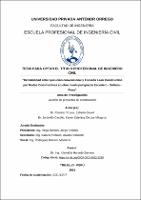Mostrar el registro sencillo del ítem
Rentabilidad entre ejecución convencional y Filosofía Lean Construction por Mudas Constructivas en obra municipal Ignacio Escudero - Sullana - Piura
| dc.contributor.advisor | Hurtado Zamora, Oswaldo | |
| dc.contributor.author | Ramirez Rosas, Estrella Gisvel | |
| dc.contributor.author | Jaramillo Castillo, Karen Estefany De Los Milagros | |
| dc.creator | Ramirez Rosas, Estrella Gisvel | |
| dc.date.accessioned | 2022-01-07T13:15:35Z | |
| dc.date.available | 2022-01-07T13:15:35Z | |
| dc.date.issued | 2022 | |
| dc.identifier.uri | https://hdl.handle.net/20.500.12759/8528 | |
| dc.description.abstract | El Perú crece y consigo el alcance de la construcción que cada vez tiene mayor competencia, y es que las pequeñas y medianas empresas deben situarse y mantenerse dentro del ranking para poder perdurar en el tiempo, debiendo destacarse ofreciendo mayor eficiencia sin perder la rentabilidad y/o ganancia por proyecto y a fin de lograrlo se debe considerar una metodología o forma de ejecución más efectiva con menos pérdidas. La presente investigación, se enmarcó bajo el enfoque metodológico de investigación de campo, y de carácter explicativa experimental; cuyo principal objetivo es, comparar la rentabilidad entre ejecución convencional y filosofía Lean Construction por mudas constructivas en obra municipal del Distrito de Ignacio Escudero – Sullana – Piura. Para hallar la comparativa se tomaron en cuenta las HH obtenidas en la aplicación de la carta balance con tiempos estimados de 1 min para el jornal diario a 8 partidas del proyecto, identificando las actividades de menor aporte, consideradas como desperdicios o pérdidas, que son definidas bajo la Filosofía Lean Construction, como mudas constructivas, siendo estas últimas de utilidad para un recalculo de montos con mejoras en los tiempos, disminuyendo las mudas; logrando resultados en términos monetarios, para la partida de piso de porcelanato y falso cielo raso de drywall, que aún con un porcentaje mayor de mudas constructivas, ganancias totales de S/. 4,506.14 y S/. 2,026.28 respectivamente. Adicional, se obtiene para cada nivel de trabajo para las partidas analizadas en ejecución convencional son 51% TP, 28% TC y 21% TNC, siendo comparados con los valores óptimos de la investigación realizada por Serpell (2002). Este comparativo confirmó el supuesto de eficiencia de la Filosofía Lean Construction con la que se planteó el análisis, demostrando que la planificación y el enfoque a futuro, identifica posibles restricciones y antecede soluciones más eficientes por manejar un mejor sistema de gestión. | es_PE |
| dc.description.abstract | Peru is growing and with it the scope of the construction industry, which is becoming more and more competitive, and small and medium-sized companies must position themselves and remain within the ranking to be able to endure over time, and must stand out by offering greater efficiency without losing profitability and/or profit per project, and in order to achieve this, a more effective methodology or form of execution with fewer losses must be considered. The present investigation was framed under the methodological approach of field research, and of an experimental explanatory nature; whose main objective is to compare the profitability between conventional execution and Lean Construction philosophy for construction changes in municipal works in the District of Ignacio Escudero - Sullana - Piura. To find the comparative, the HH obtained in the application of the balance chart with estimated times of 1 min for the daily workday to 8 items of the project were taken into account, identifying the activities of lower contribution, considered as waste or losses, which are defined under the Lean Construction Philosophy, as constructive changes, the latter being useful for a recalculation of amounts with improvements in times, decreasing the changes; achieving results in monetary terms, for the item of porcelain tile floor and false ceiling of drywall, that even with a higher percentage of constructive changes, total gains of S/. 4,506.14 and S/. 2,026.28 respectively. In addition, for each level of work for the items analyzed in conventional execution, 51% TP, 28% TC and 21% TNC were obtained, compared with the optimum values of the research carried out by Serpell (2002). This comparison confirmed the efficiency assumption of the Lean Construction Philosophy with which the analysis was proposed, demonstrating that the planning and forward-looking approach identifies possible restrictions and precedes more efficient solutions by managing a better management system. | en_US |
| dc.description.uri | Tesis | es_PE |
| dc.format | application/pdf | es_PE |
| dc.language.iso | spa | es_PE |
| dc.publisher | Universidad Privada Antenor Orrego | es_PE |
| dc.relation.ispartofseries | T_CIVIL_2014 | |
| dc.rights | info:eu-repo/semantics/embargoedAccess | es_PE |
| dc.rights.uri | https://creativecommons.org/licenses/by/4.0/ | es_PE |
| dc.source | Universidad Privada Antenor Orrego | es_PE |
| dc.source | Repositorio Institucional - UPAO | es_PE |
| dc.subject | Lean Construction | es_PE |
| dc.subject | Rentabilidad | es_PE |
| dc.title | Rentabilidad entre ejecución convencional y Filosofía Lean Construction por Mudas Constructivas en obra municipal Ignacio Escudero - Sullana - Piura | es_PE |
| dc.type | info:eu-repo/semantics/bachelorThesis | es_PE |
| thesis.degree.level | Titulo Profesional | es_PE |
| thesis.degree.grantor | Universidad Privada Antenor Orrego. Facultad de Ingeniería | es_PE |
| thesis.degree.name | Ingeniero Civil | es_PE |
| thesis.degree.discipline | Ingeniería Civil | es_PE |
| dc.subject.ocde | https://purl.org/pe-repo/ocde/ford#2.01.00 | es_PE |
| renati.advisor.orcid | https://orcid.org/0000-0003-2612-3298 | es_PE |
| renati.author.dni | 72561143 | |
| renati.author.dni | 76432203 | |
| renati.advisor.dni | 18074977 | |
| renati.type | https://purl.org/pe-repo/renati/type#tesis | es_PE |
| renati.level | https://purl.org/pe-repo/renati/level#tituloProfesional | es_PE |
| renati.discipline | 732016 | es_PE |
| renati.juror | Vega Benites, Jorge Antonio | |
| renati.juror | Salazar Perales, Alvaro Fernando | |
| renati.juror | Rodriguez Ramos, Mamerto | |
| dc.publisher.country | PE | es_PE |
| dc.date.embargoEnd | 2023-01-06 |
Ficheros en el ítem
Este ítem aparece en la(s) siguiente(s) colección(es)
-
Ingeniería Civil [1149]


